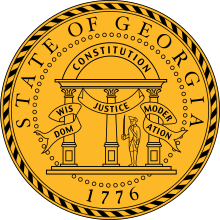1924 Georgia gubernatorial election
The 1924 Georgia gubernatorial election took place on November 4, 1924, in order to elect the Governor of Georgia.
| |||||||||||||||||
| |||||||||||||||||
| |||||||||||||||||
| Elections in Georgia | ||||||||
|---|---|---|---|---|---|---|---|---|
 | ||||||||
|
||||||||
|
||||||||
|
|
||||||||
Incumbent Democrat Governor Clifford Walker was unopposed in the Democratic primary.
As was common at the time, the Democratic candidate ran unopposed in the general election so therefore the Democratic primary was the real contest, and winning the primary was considered tantamount to election.
Democratic primary
The Democratic primary election was held on September 10, 1924. As Walker was unopposed, there was no run-off.
County unit system
From 1917 until 1962, the Democratic Party in the U.S. state of Georgia used a voting system called the county unit system to determine victors in statewide primary elections.[1]
The system was ostensibly designed to function similarly to the Electoral College, but in practice the large ratio of unit votes for small, rural counties to unit votes for more populous urban areas provided outsized political influence to the smaller counties.[2][3]
Under the county unit system, the 159 counties in Georgia were divided by population into three categories. The largest eight counties were classified as "Urban", the next-largest 30 counties were classified as "Town", and the remaining 121 counties were classified as "Rural". Urban counties were given 6 unit votes, Town counties were given 4 unit votes, and Rural counties were given 2 unit votes, for a total of 410 available unit votes. Each county's unit votes were awarded on a winner-take-all basis.[2][3]
Candidates were required to obtain a majority of unit votes (not necessarily a majority of the popular vote), or 206 total unit votes, to win the election. If no candidate received a majority in the initial primary, a runoff election was held between the top two candidates to determine a winner.[4]
Candidates
- Clifford Walker, incumbent Governor
Results
| Democratic primary[5][6] | |||
|---|---|---|---|
| Candidate | Votes | % | CUV |
| Clifford Walker | 222,395 | 100.00 | 412 |
General election
In the general election, Walker ran unopposed.
Results
| Party | Candidate | Votes | % | ± | |
|---|---|---|---|---|---|
| Democratic | Clifford Walker | 152,367 | 100.00% | ||
| Turnout | 152,367 | 100.00% | |||
| Democratic hold | Swing | ||||
References
- "County Unit System". Georgia County Clerks Association. Archived from the original on 31 May 2008. Retrieved 8 June 2020.
- "Eugene Talmadge". The Jim Crow Encyclopedia. The African American Experience. Archived from the original on 23 January 2015. Retrieved 12 August 2013.
- "County Unit System, eh?". Richard B. Russell Library for Political Research and Studies. 6 October 2011. Retrieved 8 June 2020.
- Buchanan, Scott (13 June 2017). "County Unit System". New Georgia Encyclopedia. Retrieved 8 June 2020.
- Congressional Quarterly 1998, p. 107.
- Georgia Register 1925, p. 171.
- "GA Governor, 1924". Our Campaigns. Retrieved 11 June 2020.
- Glashan 1979, pp. 68-69.
- Hunt Lyman, Robert, ed. (1925). The World Almanac and Book of Facts for 1925. New York, NY: Press Publishing Co. (The New York World). p. 822.
- Congressional Quarterly 1998, p. 48.
- Dubin 2013, p. 10.
Bibliography
- Gubernatorial Elections, 1787-1997. Washington, D.C.: Congressional Quarterly Inc. 1998. ISBN 1-56802-396-0.
- Glashan, Roy R. (1979). American Governors and Gubernatorial Elections, 1775-1978. Meckler Books. ISBN 0-930466-17-9.
- Dubin, Michael J. (2013). "Annual Summary". United States Gubernatorial Elections, 1912-1931: The Official Results by State and County. Jefferson, NC: McFarland & Company, Inc.
- Compiled by Ruth Blair, ed. (1925). Georgia's Official Register, 1925 (PDF). Atlanta, GA: State of Georgia, Department of Archives and History.
